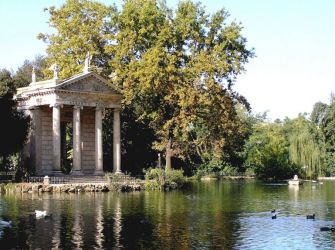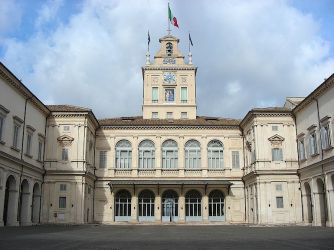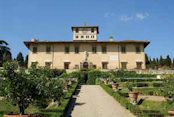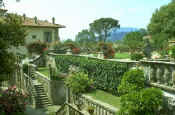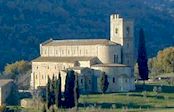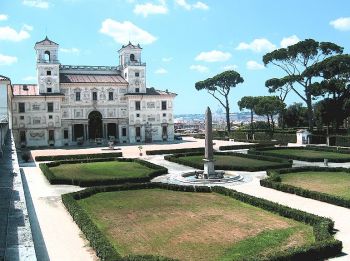Gardens of Rome
At the time when the Medici family were at the height of their power, Florence was the leader in villa and garden design, but as the Medici declined so Florence lost its pre-eminence in this sphere, to be replaced by Rome. From the middle of the 16 C, the predominance of the Church made conditions in Rome extremely favourable for the development of the art of gardening. Pope Paul III was the last of the Popes who contrived to found an independent principality for his nephew, and after the fall with Paul IV of the House of Caraffa, no Pope dared to attempt it. It was thus all the more imperative that papal “nephews” should gain an entrée to the noble families of Rome, and how could they do this more effectively than by showing their power and might in grand country seats and fine buildings? Consequently there arose, besides the palaces within Rome itself and the proper country houses outside - in the same way as the "hortus" of ancient Rome - the town villa, a really good casino or small house with a garden that was continuously extended. There is probably no other city in the world that has so preserved the stamp of beauty by its gardens, throughout the period from the 16 C to the 19 C. It is only through the development of Rome into a modern capital during the past fifty years or so that one after another these gardens have disappeared.
In addition to the political motivation, there was an additional impetus at this time - but not before this time - favourable to the formation of large gardens within the precincts of the city. For a surprisingly long period, Roman building had been confined to the valley of the Tiber: on the hills there was a constant shortage of water. The huge supply from the old water courses was drying up. The single conduit made by Sixtus IV, called the Acqua Vergine, had been unable to satisfy the demand for a long time. The Popes who followed him had always improved it, reconstructed it, and eventually made it as good as it could be made. But it was Pope Sixtus V who constructed a second conduit, the Acqua Felice, and afterwards Pope Paul V made a third, the Acqua Paolo, so that finally there was an adequate supply, even for the hilly districts. For the first time Romans were able to make use of the hills, with their many advantages in position and especially in charming views, for laying out larger gardens and thus satisfying their great love of fountains.
In addition to the political motivation, there was an additional impetus at this time - but not before this time - favourable to the formation of large gardens within the precincts of the city. For a surprisingly long period, Roman building had been confined to the valley of the Tiber: on the hills there was a constant shortage of water. The huge supply from the old water courses was drying up. The single conduit made by Sixtus IV, called the Acqua Vergine, had been unable to satisfy the demand for a long time. The Popes who followed him had always improved it, reconstructed it, and eventually made it as good as it could be made. But it was Pope Sixtus V who constructed a second conduit, the Acqua Felice, and afterwards Pope Paul V made a third, the Acqua Paolo, so that finally there was an adequate supply, even for the hilly districts. For the first time Romans were able to make use of the hills, with their many advantages in position and especially in charming views, for laying out larger gardens and thus satisfying their great love of fountains.
The Quirinal
In love of fountains, no one surpassed the Pope himself. The Vatican lay so low that it had never been a healthy place to live in, and never safe from malaria, so Gregory XIII gave orders that “a home should be prepared for himself and his successors in which they could enjoy a perfectly pure air.” He then summoned Flaminio Ponzio, who in 1574 began to build the palace on Monte Cavallo, The Quirinale. Before this, the Popes had set up a sort of summer recreation place there, apparently in the Benedictine cloister. At any rate, it is said that Paul III stayed there a few days before his death in 1549. Certain cardinals had gardens there, and Cardinal Carpi brought a fine collection of statues to his, which was also furnished with pergolas and grottoes, and was a model for all to copy. Also Cardinal Ippolito d’Este of the great villa at Tivoli had had gardens here before 1550 that were designed with artistic lattice-work by Girolamo da Carpi. Some of these passed into the Pope’s hands either by gift or sale, and came to form part of the present estate of the royal garden.As late as 1580, Montaigne considered the gardens of Cardinal d’Este on Monte Cavallo to be among the most beautiful in Rome. The palace itself was not finished by Paul V until the beginning of the 17 C, but the garden must have been at the height of its beauty in the last decades of the 16 C. Duke Frederick saw it in 1599 and describes it in exactly the same way as Evelyn does forty-five years later. He particularly praises the magnificent view over the whole of Rome, the precious trees, herbs, and foreign plants, „the very wonderful and peculiar water devices,” of which he can mention scarcely a tenth part. Still, neither the water stairways nor the great tanks interested him so much as (under a semicircular arch) “a grand organ piece with four registers most cleverly made, which if you turn the water on with a tap begins to play by itself just as if a good organist was playing on it.” He also praises a wood of laurels, and many walks arched with greenery, as having everywhere beautiful water-works and figures of marble. He ends his story with the melancholy reflection (more often felt about the works of a Pope than about other people’s) that anyone who begins to build is sure to die before he has finished.
The sunken grotto with the organ and the large tank in front with plane-trees round it has been ascribed to Maderna, and this part which is not connected with the buildings by any general plan gives to the garden a sort of design of its own. The largest stretch on the level shows dense thicket and paths with hedges which were particularly admired by Evelyn. In his time, they were somewhat above the height of a man, and made of myrtle, laurel, orange and even ivy, but in that case they were trained over lattice-work. Evelyn also admires the water stairs and the organs, and says of the former that he saw in one of the underground natural grottoes a basin made out of a gigantic piece of ancient porphyry, where from a cascade flowed down steps to a grotto whose roof was inlaid with mosaic work. Evelyn was told that the gardener was paid 2000 scudi a year for keeping the garden in order, but though he regards this as one of the best and most attractive in Rome, its advantages cannot be found in any consistent artistic plan, but rather in the ornamentation of particular parts.
Villa Medici and the Borghese gardens
The Villa Medici is an architectural complex centred on the villa whose gardens are contiguous with the larger Borghese gardens, on the Pincian Hill next to Trinità dei Monti in Rome. The garden of the Villa Medici at Monte Pincio came into existence almost at the same time as the Quirinal. It is essentially a great terrace made for the view. A rather narrow strip between the old town wall and the Field of Mars, it lies high on Monte Pincio, the garden mountain of the ancients. The palace of the Quirinal never succeeded in uniting house and garden - that was achieved by the architect in his limited space at the Villa Medici by making an unusual alteration. The place was on the site of the ancient gardens of the Acilians, and before Cardinal Francesco bought it had changed owners several times. When, about 1550, Ligorio made his sketch of an antique stairway a certain Cardinal Crescenzio possessed a villa here, and soon afterwards it was bought by Cardinal Ricci da Montepulciano, a favourite of the Medici, and he began building a villa according to the plan of Annibale Lippi. But this villa seems to have advanced slowly, for when Cardinal Francesco bought it, it was in a very unfinished condition. He then enlarged the garden on the north-east side by adding a piece of ground that had belonged to a lady of his own house, Catherine de’ Medici. Thus it was he who brought the villa and garden to its present fairly well preserved state, and it must be regarded as his work. On the side next to the street the house has an extra story below, which gives it the character of a palace; and there is a sort of sober quiet treatment of each floor that seems to suggest that the façade and its supporting wall would wish to serve as a protection for the precious place on the hill behind. The garden façade is quite different; indeed it gives the most festive picture that the Renaissance has to show.We pass from a pillared front hall, divided into three parts, to a semicircular balcony, in the middle of which stands a Mercury fountain by Giovanni da Bologna. There were statues in the hall, and in front of the stairs between the pillars were the two antique lions that have now found a place in the Loggia dei Lanzi at Florence. The whole façade keeps its pretty, light character by having its top story set much farther back than the others, together with a turret at each end and some antique relief work.
As was said before, Ferdinand de’ Medici bought in 1584 the whole collection of the Cardinal della Valle, and a great part of this relief decoration came from it. Ferdinand, moreover, like della Valle, and like many other men, intended to convert his villa into a great garden museum, and everything—gardens, buildings and all—was designed to serve this end. After early modest beginnings the greatest skill had been attained, and it is important to observe that again it was one of the Medici family who produced the. finest example at Rome. Thus the façade, with its fine effective decoration of antique sculpture, shows the promise that the garden is to fulfil, The only exception to the antique style is a wing in front of the house on the right-hand side, for this wing is the boundary of an open space reserved for knightly games. It has a fountain in, the centre, and statues at the side.
The chief garden extends from north-east to south-east at right angles to the axis of the houses which has to end at the high town wall. This garden was supplied in Ferdinand’s time with the finest antique statues and an obelisk. Some specially good statues were set in niches which were made in the high wall of a terrace on the south, and between them the wall was covered with orange-trees. On the old town wall the sleeping Ariadne reclined under a pretty loggia. Along the Passeggiata del Pincio of modern days there stood under an open roof of a semicircular building the daughters of Niobe grouped round the horse that was with them when they were found; they came into the cardinal’s possession in the year 1583.
The garden has preserved its earliest division into formal square beds, but the old pictures give a good view of the ever-changing style of its plantation. The earliest drawing we have belongs to the sixteenth century, or at any rate to the time of Ferdinand’s rule, and shows the change from the dignity and taste of the cardinal to that of the grand duke. The beds are now bordered with low hedges or else with trellis-work of wood. In the axis of the house they have little fountains in the centre, on the outside a circle of dwarf fruit-trees, and the space between is filled up with pretty geometrical beds of flowers. The plan calls the flower-garden by the usual old name of beds for simples. The space on the north, now covered by a dense wood of oak, was at that time mostly planted with fruit-trees, The paths are even now partly covered over with foliage, and have pavilions at the corners where they meet. The close plantation of the northern part appears first in the drawing that dates from the middle of the seventeenth century. The Duke of Würtemberg in 1599 finds the broad walks “enclosed with hedges as with a rope”.
The southern end of the garden is peculiar, and has in part remained as it was, It consists of an important high-built terrace enclosed in a fine balustrade above the dividing wall mentioned before, which has statues in niches. Here stood the old round building on the hemicyclium that is now in the garden of the Sacré Coeur, Cardinal Ricci probably found it in ruins, and anyhow it served him as a convenient foundation for a circular hill planted all round with cypresses—seen by Evelyn when they were cut into the form of a fortress, with a pavilion and a fountain on the top of the mound. The earliest drawing shows a straight stairway on the garden side, fountains on either hand, and a spiral path running round.
This plan of an artificial mound we saw in ancient Assyrian times as well as in the Middle Ages. It was not at all common at the period of Italian Renaissance, but was used continuously in northern countries while the formal style was still popular. Its original intention was to provide a fine view from enclosed gardens; but in the south it was no longer needed because of the extension of terraces and the high situation of country houses. The Villa Medici would have had a fine view without the addition of this extra height, and the prospect seen from the high gardens was always praised—on one side the town with its domes and towers, on the other the beautiful garden land, at that time sprinkled with any number of little villas which were gradually absorbed into one large one, the Borghese. Gurlitt describes it as “ a garden to look out of rather than to look into,” but the splendour of it must have been increased by the noble works of art and the garden full of fruit and flowers in strong contrast with the sombre cypresses covering hills and terraces. And the view must have been magnificent—in its own way absolutely unique.
Later on, when Tuscan grand dukes gradually lost interest in the Roman villa, the precious statues were one by one removed to Florentine collections, though the last Medici of them all, Jean Gaston, did once make a great renovation. In the year 1801 the villa was converted by Napoleon into the home of the French Academy of Art, and has remained so to the present day. At a later date an attempt was made, by setting up a few casts there, to charm back to the place some trace of its former beauty.
Those who founded the Villa Medici enjoyed the great advantage of a fine water supply, for the Acqua Vergine was restored by a long succession of Popes to its former efficiency as a conduit, and watered the Hill of Gardens (Collis Hortorum). According to the first drawing, the fountain on the hill of cypresses leapt to a height of twenty-five ells from the pressure of this conduit, and Evelyn mentions with astonishment that the fountain at the entrance to the palace throws its waters to a height of fifteen ells [1 ell = 1.14m].
Villa Montalto
On the east side, towards the Esquilme and Viminal, there was a very scanty supply, and it was just here that another cardinal, Montalto, elected to build the Villa Montalto in a grand style. This cardinal made a victorious exit from the Conclave in 1585 as Pope Sixtus V. To no other Pope have so many legends been attached as to this one, originally Felice Peretti, who worked his way up from the lowly estate of a shepherd boy to the highest position in Christendom, always believing in his luck, which he thought his father had bestowed on him with the name Felice that he liked so much to hear. This Pope is described by Ranke as a man of frugal life, who quickly remedied the ruinous condition of Church finance.In spite of his economy, however, he indulged his fancy for building. The villa he started as cardinal he brought to completion as Pope, and in the handsomest way. It was adorned with choice works of ancient art, although at one time he had scornfully opposed the cult of antiquity. There is an anecdote that relates how the cardinal suddenly was compelled to give up building his villa, when Gregory XIII., himself a great lover of building, was provoked by hearing that a mere cardinal was making a finer villa than the Pope’s. Then Montalto thought it advisable to hold back, feigning illness. But at this point the architect Domenico Fontana, who also believed in his master’s good luck, bought the entire place so that he could continue the work, and later on the Pope heaped honours on his head.
This story shows how important to the Romans was the size and splendour of this garden. But one reason why it was interrupted must have been the deplorable want of water in this part of the city, and the first order given by the Pope on the very day he ascended the papal chair, was that Domenico Fontana was to undertake the construction of the water conduit, Acqua Felice. Thus did he inaugurate a work that, as Ranke says, "brought more honour and glory to him in the town than was paid to any other Pope.” This gigantic work filled him and the architect with joy and pride when two years later it was completed. All Rome took part in the jubilation, and Torquato Tasso wrote a pompous poem in its praise, following the water on its path below the earth till gleefully it greets the sun which once shone upon the mighty Augustus. It was felt that now something had been made worthy of antique glory, and so it should be celebrated in an antique style. The Pope had one arm of the conduit taken through his garden and thence to the Quirinal, the other was to pour forth its streams at the Moses fountain at the Thermæ.
The Villa Montalto which only a few decades ago stood “ beautiful and dignified in wild surroundings “ is now completely swamped in a sea of houses, stretching from the Esquilme and Viminal between the church of S. Maria Maggiore and the Thermæ. The architect, Domenico Fontana, was the first of a whole family of architects, who gained their chief reputation by the laying out of gardens in the seventeenth century. Like his master, Domenico had risen in the world; from a bricklayer’s apprentice in the service of Sixtus V. he had become his architect, and finally he was almost exclusively employed. The casino at the villa was not large and its façade was only approached by one entrance loggia, and Fontana’s particular ability is shown in his spacing, which is remarkable in the massive features of the garden grouped about the Palazzo Felice. One can imagine nothing more magnificent than the approach to the casino from the side of the Esquilne near the church of S. Maria Maggiore.
Through a large gate one steps into a garden where three splendid cypress avenues diverge; and at the point where they end there are two grand lion fountains, which seem to be fastened together by a kind of clasp or chain. The middle avenue leads directly to the entrance loggia with its three arches, and we must think of it as described by Evelyn—full of statues, inscriptions, reliefs, and other antique marbles, “such that one could not imagine anything more splendid and gay.” The palace has giardini secreti half-way to the height of the first story, and there is a higher terrace behind, There are various grottoes in the walls, and behind the casino there is a semicircular level part with a fountain and vases put up between hedges.
A large cypress avenue starting from here crosses another that began at the second gate at the baths, in a round place where a great many water devices are assembled. These two main avenues reached the wrought-iron gates of the flower-garden, and were then continued in the park which surrounds this garden on the north and east; and both of these avenues, which end in hills with statues upon them, give a point de vue very clearly, as they are straight as well as long.
If we compare this with all the other gardens we have examined, the continuity is obvious and significant. We have always found hitherto that in the flower-garden at least there has been a formal distribution of beds in squares and bordered with hedges, or else paths arched over with foliage. Then in the gardens of Ligorio, Vignola, and others, the architectural effect has been obtained by either water or terraces. Here for the very first time the artist is working in a larger style with perspective. Long avenues are made with definite endings, architecture or sculpture. The beds must be arranged to suit the form of the avenues: large, open, or semicircular spaces at the beginning of the avenues increase the grandeur of the outlook, as Evelyn particularly notes. Their size is increased once more by the extension of the flower-garden into the park; the importance of this feature will be seen later on. The many beautiful fountains—unhappily all entirely perished—are something more than an adornment of separate parts of the garden or avenues, for they really dominate the whole composition, and are a leading motive. Villa Montalto is in this respect not only the first in a particular style, but it is destined to be for long the only one. More than half a century later Fontana’s ideas are united to those of the French garden, and proceed to what is still more important and built on a larger foundation.
Villa Montalto had not only its own points de vue to rejoice in, but also the help of buildings outside. This attraction was not the least that was felt by the Pope when he chose the site for his villa, seeing that on one side there were the mighty towers and cupolas of the church of S. Maria Maggiore, on the east, looking through a great avenue, the little church of San Antonio, and on the west the ruins of the baths of Diocletian which extended right up to the park. Ever since Alberti's time the view from the garden had been an important consideration, and in a country that was so rich in the beauties of landscape scenery, it was easy enough to find a view. But Rome offered more than this with its abundance of ruins and churches, and it did not take long to see how a villa would be enriched by a view of such architecture.
Villa Celimontana (previously Villa Mattei)
A church is actually a component part of the Villa Celimontana, or Villa Mattei as the original, no longer extant structure was called, traces of which, though much effaced, can still be perceived on the hill of Coelius. This little church, S. Maria in Domenica - also called della Navicella from a small ship that Leo X had once put up there, an imitation of an antique find - has the villa garden on three sides of it. Beside its façade is the entrance gate, and this ancient basilica, with its pretty front hall (ascribed to Raphael), represents a casino or a lodge for the palace which stands in the middle of the garden. Also on the east is the picturesque round building of S. Stefano, also dating from early Christian times and built on ancient foundations. In fact, it is on such foundations that the whole garden is built, and the old walls, plainly recognisable by their opus reticulatum, are made use of as terrace walls, and part of an old conduit in one corner has at some time been entirely absorbed into the garden. Towards the south the eye glides over the Baths of Caracalla to the Campagna backed by hills.This fine place was selected as a villa site by Cyriaco Mattei, a scion of an old Roman family of nobles. It must have been begun before 1582, and indeed nearly finished by then. At that date, Rome presented to this citizen an obelisk which had once stood at Aracoeli, but had been removed when the Mattei family erected a chapel there. Cyriaco set up the obelisk in the place of honour in his so-called amphitheatre, a place in circus form, which adjoined the casino at the side, and on one rounded end had a colossal bust of Alexander. This circus-shaped prato with cypresses round it serves in a sense to identify the Villa Celimontana, for whereas in similar features were common in Florentine villas, the idea had not yet penetrated to Rome, and therefore all travellers make remarks about the Villa Celimontana.
The original structure has now been entirely replaced. On the right side of the circus in the middle of the garden stood the casino. According to the first drawing of it, it must have been much smaller than it is to-day or than it appears in the engravings of the later 17 C, and the original garden is certainly not large.
It was not till the 17 C, or in any case, not until after Cyriaco’s death, that the park-like region on the north-west was added, and laid out in the form of a star. At that time, the ruins had not been included in the garden grounds. But it was later still, in the 19 C, after the place had passed out of the hands of the Mattei family, that the great extension took place and embraced the park on the west and south which was now laid out in the English fashion.
The garden of Cyriaco was, like that of the Villa Medici, first and foremost a garden museum. The beds were of the usual four-cornered shape and planted like those at Villa Medici. Corresponding to the circus at the side, in front of the house there was a round space with a fountain in the centre, from which the wide walk led to the entrance of the church. The ancient foundations are utilised for asymmetrical terraces on the south and east. Though the space was small, the drawing indicates countless objects that were worth seeing - seventy-seven antique statues, fifty-three busts, the Eagle and other fountains, two of which, at either end of the garden, were joined by a bridge over a stream which ran behind the house.
Accommodations in Rome © ammonet InfoTech 2006 - 2010. All rights reserved.

